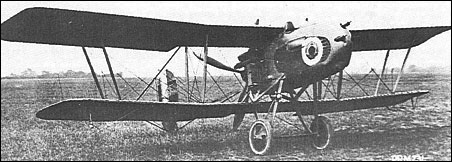|
| Curiously retrogressive in design when built in May 1917, the pusher fighter with boom-carried empennage being decidedly passe at that stage in Worid War I, the F.B.26 single-seat fighter had its nacelle attached directly to the upper wing. The original concept provided for a single 7.7mm Lewis gun, but an additional Lewis had been introduced by the time that the F.B.26 reached Martlesham Heath for official testing in July 1917. Power was provided by a 200hp Hispano-Suiza engine, but inadequate cooling led to the original single flat radiator being replaced by two separate radiator blocks. On 25 August 1917, the prototype was spun into the ground by Vickers' test pilot Harold Barnwell. Nonetheless, a month later, on 19 September, a contract was placed for six examples of a modified version of the F.B.26. The wing structure was completely revised, radiator blocks were attached to the nacelle sides and a larger vertical tail was introduced. Interest in the F.B.26 centred on its potential as a Home Defence fighter, and it was proposed that armament would consist of two Lewis guns coupled with an Aldis sight and capable of several degrees of elevation and depression. However, in order to obtain greater firepower, the nacelle of the F.B.26 was modified to permit installation of an Eeman three-gun universal mounting. The first two F.B.26s had the trio of Lewis guns fixed to fire horizontally, but it was intended that the next four aircraft would have a modified Eeman mounting capable of 45° of elevation.
The first of the modified F.B.26s was flown in December 1917 with a 200hp Hispano-Suiza engine. After testing at Martlesham Heath, this aircraft was assigned to No 141 Sqn in February 1918 for service evaluation. It was concluded that the F.B.26 was unsuited for Home Defence duties and work on the incomplete machines was halted, although the second and third examples had been completed and flown meanwhile. As the basic design was considered to possess potential in the close air support role, the second of the modified F.B.26s was fitted with a redesigned nacelle incorporating armour protection for the pilot and a 230 hp Bentley B.R.2 nine-cylinder rotary. This armoured "trench-strafer" was assigned the designation F.B.26A, and, under the official nomenclature scheme introduced in the spring of 1918, became the Vampire II, the F.B.26 being the Vampire I. In the event, the Vampire II had still to be completed by the end of June 1918, and thus came too late on the wartime scene.
 | A three-view drawing (1278 x 906) |
| WEIGHTS |
| Take-off weight | 921 kg | 2030 lb |
| Empty weight | 667 kg | 1470 lb |
| DIMENSIONS |
| Wingspan | 9.63 m | 32 ft 7 in |
| Length | 7.14 m | 23 ft 5 in |
| Height | 2.87 m | 9 ft 5 in |
| Wing area | 24.80 m2 | 266.94 sq ft |
| PERFORMANCE |
| Max. speed | 195 km/h | 121 mph |
| Ceiling | 6860 m | 22500 ft |
| Evan Davies, e-mail, 03.07.2022 07:19 Have studied this plane; have additional materials.
Please contact me at the attached address. Many thanks reply | | gangya, 21.06.2011 05:38 I just came across blueprints at a flea market....we think they are very interesting. reply | | Linda Rawlinson, e-mail, 06.06.2010 23:07 Yes, I was wanting to find out more information about this aircraft as I just came across blueprints at a flea market....we think they are very interesting. reply |
|
Do you have any comments?
|
| 
COMPANY
PROFILE
All the World's Rotorcraft
|








